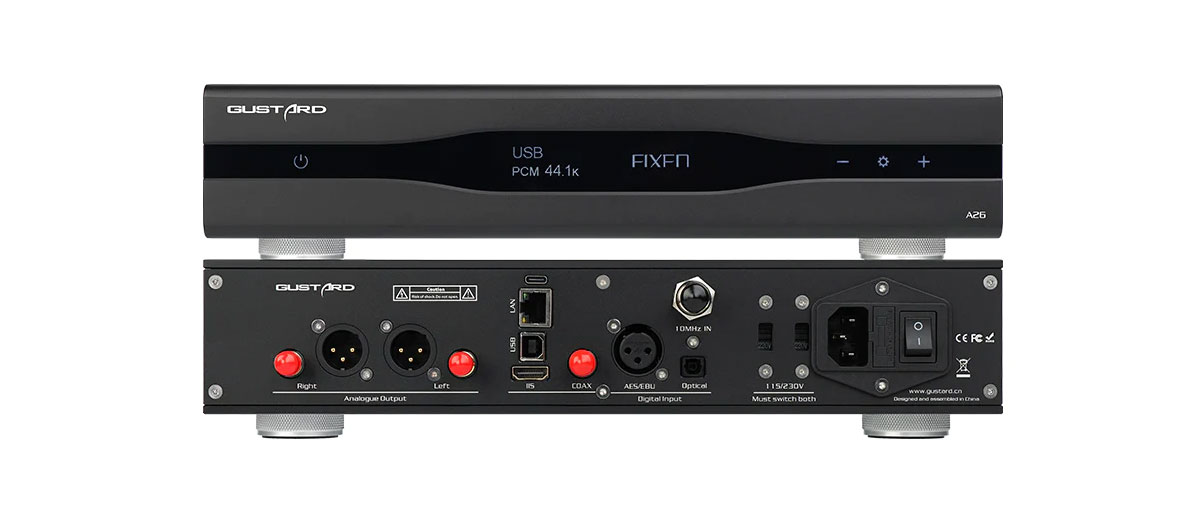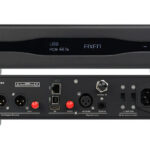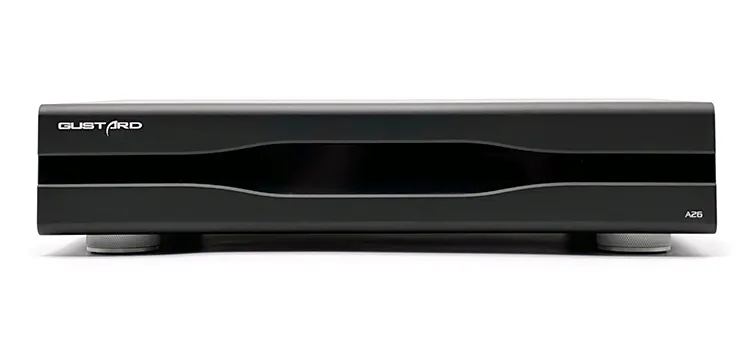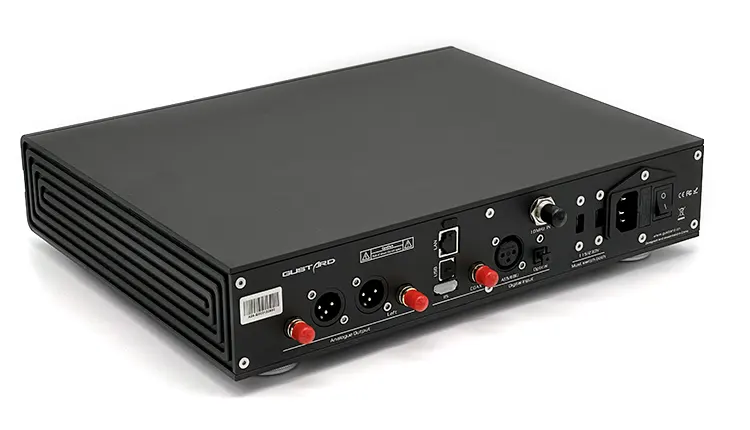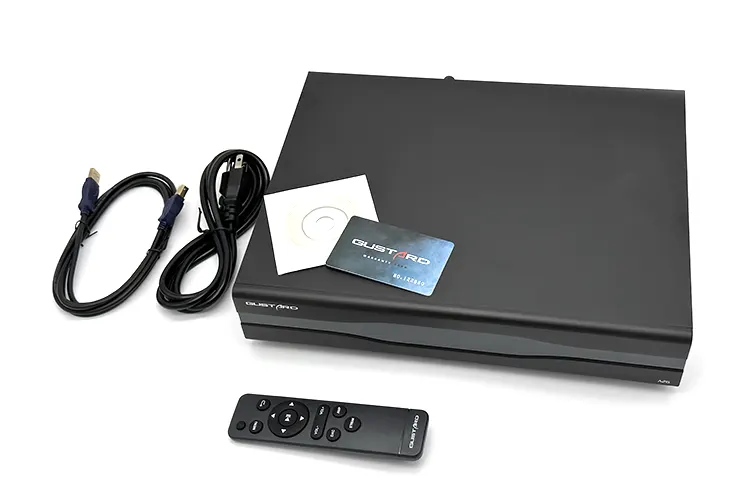We review the Gustard A26, which is a high-end DSD512 and PCM 768kHz-capable balanced desktop DAC with LAN streaming capability. It is priced at $1499.99.
Disclaimer: This was sent to us as a sample for our honest opinion. Headfonics is an independent website with no affiliate links or services. We thank Shenzhen Audio and Gustard for their support.
To read more about Gustard products we have previously featured on Headfonics, click here.
Note, that this article follows our latest scoring guidelines which you can read here.
Our previous Gustard DAC reviews, the X18 and X16 were competitive for the mid-fi market. However, with the release of the R-2R R26 and their new AKM DAC, the A26, we are pretty much in flagship territory.
Their current top-of-the-line R2R-based R26 DAC was met with many positive reviews, it is unfortunate we haven’t had the chance to do an in-depth assessment ourselves. Coincidentally, the success of the R26 opened an opportunity waiting to be filled in.
Gustard has decided to split the audience and make life just a bit more complicated with the arrival of the A26. Gunning for the best of both worlds, the addition of the A26 welcomes consumers with a craving for a high-end delta-sigma DAC.
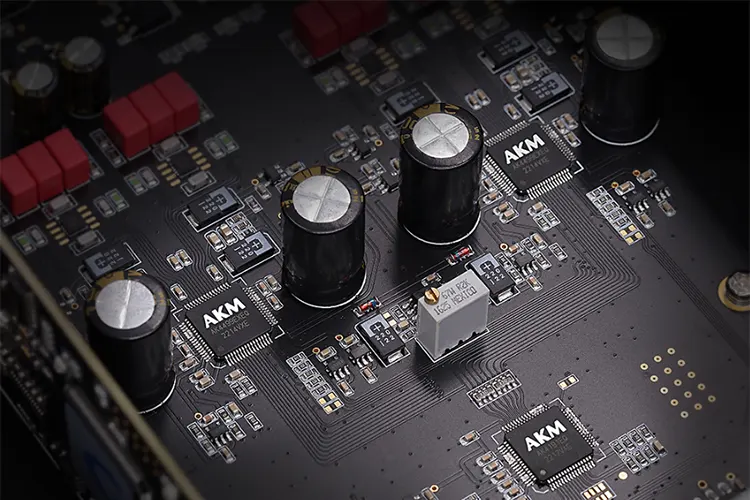
Tech Highlights
Late last year, AKM released a duo of flagship chips to attain complete separation of digital and analog circuitry which found a place inside the A26.
Breaking away from what used to be done inside a single chip, the AK4191 has been designed and conceptualized for discrete digital filtering and delta-sigma modulation. Where the traditional digital-to-analog conversion happens is in a dual-DAC AK4499EX implementation.
I haven’t tried any other DACs utilizing the AK4191 and AK4499EX tandem nor have I come across the concept itself being used widely. So, the advantage of going to such lengths seems a bit trivial for me at the moment but I understand that the A26 doesn’t deserve anything less.
Going through some of the other hardware specs, the USB module is an older gen XMOS XU216 which is still talented and allows for up to PCM 768kHz and DSD512 decoding as well as MQA unfolding. A K2 clock synthesizer is also housed inside together with an exclusively made FPGA circuit for signal routing and other stuff.
A feature of the R26 that is not in the A26 is the Bluetooth antenna. Streaming is now completely reserved for LAN users who listen through ROON, UPnP, and HQPlayer NAA.
Now, depending on your tastes, the fact that Gustard has now removed the physical power button and control wheel could swing either way. Where I stand on this is that while mechanical components feel more engaging, the touch sensors up the presence better.
Design
I carried the package up a few flights so I already knew the A26 would be heavy. It was still a different involvement when I was prepping the A26 and finding a place for it on my listening corner. Using two hands most of the time, I felt fatigued after just a few minutes of moving its hulking 330 x 260 x 65mm body around.
The A26, and the R26 for that matter, are Gustard’s most ambitious showpiece yet and the progression of their designs shows. Simple yet worthy of a few snaps, the front of the unit is sleek and the characteristic accents on either side only deepen the firm lure.
More on the grills adorning the sides, the silver color option does help it pop more. And, the almost closed-off internals of the A26 breathes through the slim slits carefully hidden on its upper portion.
Ditching their iconic control wheel for a set of touch sensors, Gustard enabled a symmetric design on the A26. It does show fingerprints quite easily, so either use the remote or wipe it pretty often to keep it clean.
The glass strip decorating the front of the A26 now has a central OLED display. It looks better put together than the slightly right-biased display on the R26. Gustard also upgraded the UI by decongesting the settings menu for a less busy look.
I/O
There’s no antenna peering behind the A26 unlike its R2R-based brother, the R26. This removed any chance for the A26 to have WiFi, let alone Bluetooth connectivity.
It doesn’t mean the A26 doesn’t have a heart for chord cutters. Set it up with a LAN cable and you’ll unleash one behemoth of a streaming machine. That is if you use platforms like ROON and the limited amount of service the A26 supports for now.
The USB, IIS, and LAN digital inputs of the A26 all are capable of 32BIT/768kHz PCM, DOP 256, Native DSD512, and MQA. Endorsers of Coaxial, AES, and optical inputs will only lose access to Native DSD but will retain PCM, DOP, and MQA with only a few compatibility differences.
On top of the optical input, there is a 50Ω BNC input reserved for when the internal clock needs upgrading with a dedicated clock like the C16 and C18 units Gustard offers. I’m yet to try another DAC aside from my Qutest that uses BNC as digital inputs.
For the outputs, there seems to be no setting to alternate between the XLR and RCA connections. With a signal always coming out of both, balanced amplifiers will receive 5Vrms while components plugged through via RCA will max out at 2.5Vrms.
There is no digital passthrough in the A26 so only analog signals come out. The measured dynamic range is >127dB and the THD+N is <=0.0001% which are both respectable.
Controls
Since no printed manual is included out of the box, non-techies may find it frustrating but to understand the deeper controls, one should go to Gustard’s website to retrieve the manual.
For those who can’t be bothered with the added step, don’t get too excited, before plugging in the A26 make sure the two voltage selectors are flipped to the correct one based on your region. There’s a subtle but handy reminder printed behind the unit about it.
Relays will click into place when the power switch is toggled at the back and once again when awoken from standby via the touch screen or the remote. Just like that, with a short startup sequence, the A26 is ready.
By default, it will automatically dim the central OLED display after a few seconds while waiting for a command. The touch controls on either side will remain active and not get affected by the screen saver.
With a pretty limited selection of available touch sensors to receive user feedback, Gustard had to give a secondary function to the two volume buttons. I still didn’t find any issue with it since the settings menu has a nice UI that isn’t too complicated so the learning curve is very low.
The remote doesn’t have any hidden or special functions relevant to day-to-day use. As a convenience factor to the a26, it only indicates that the DAC is suitable for long-distance setups.
One of the settings users should decide on is the digital attenuator of the volume. An internal switching is being done by the A26 at the -24dB mark if the attenuator is set to Auto to help with dynamic range. A relay is audibly heard indicating a hardware-level modification happened.
Packaging & Accessories
One of the joys of acquiring new gear whether bought or gifted is the anticipation of taking it out of the box. We were unfortunately stripped of the experience since the original box of the A26 was replaced during shipping. Thankfully, everything inside is still intact.
As a twin to the R26, the accessories provided are practically the same. There is a remote, power cable, USB-B cable, warranty card, and a minidisc.
The remote has a Gustard logo on the bottom to set it apart from other remotes lying around. Aside from this feature, there’s nothing too special about it seeing it is mostly built with cheap plastic that at least seems rugged enough for daily use.
I initially tossed aside the USB cable provided without taking a proper look. It took me a while but when I noticed that the terminations are gold plated and the wire has a substantial gauge, I thought it was worth a try nonetheless.
Seeing the supplied minidisc to the drivers reminded me of the days my dad still lugged around a huge camcorder on our vacations. It’s already 2023 and most don’t even have disc readers anymore. I think Gustard can leave this out next time especially now that everything can be downloaded on the internet.
Getting to the unit itself, some of the rear ports are protected by covers. From the front, while the A26 came wrapped in a thin sheath of plastic, Gustard neglected to include a screen protector for the glass strip running across.
Sound Impressions
Sound impressions were compiled using the Earmen CH-Amp and ST-Amp amplifiers combined with the Dan Clark Ether 2 and the Audio Technica ATH-ADX5000.
Summary
The A26 is not a flashy DAC sonically. While others tried to break the mold, Gustard settled on a safer tuning. What justifies the asking price is the addition of the little things summing up into an amazing product.
The bass quantity coming out of the A26 is deep and expansive and it plays pretty tight with the rest of the frequency. Its sway is more like a cornerstone holding everything together plus it has a slightly bouncy timbre to lessen the seriousness.
Details of vibrato and rougher notes get squeezed out but in a way that is convincing and not grainy. I’d say it outclasses the internal DAC of my Burson Conductor 3 Reference leaving it sounding leaner and brighter.
I’m hearing more things to unpack and enjoy in the A26 as the voice of a regal singer gets fleshed out with microdetails and better space. And for treble-sensitive listeners, the A26 quells shouty singers and instruments while preserving the power necessary to build the scene.
Timbre
Like adding cream to a freshly brewed coffee, the A26 takes out the bitterness from a featureless drum kick by adding heft and power. It wakes up synths with size and rumble, creating a cornerstone that is gently expressive but not too hasty.
The low-end mass has some substance but its wide staging capability allows it to retain a satisfying holographic presentation. Even when playing boisterous notes that challenge other DACs, the control and bite remain tight.
Guitars convey a neutral twang that curves away from rigid sterility and brings a satisfying draw to the music. The crisper edges will come in with certainty then a soft ripple of space softens the scene for a relatively easygoing and organic overtone.
The A26 does impose a bit over the vocal region but the faintest of notes do reverberate with accuracy. With a hint of warmth, vocals are guided to handle all types of genres with the right amount of engagement and linearity.
Providing a tonal balance that is not that peaky in the treble region, I like to think that the A26 is a suitable instrument for giving insight into dynamic songs. The electric guitar riff I listened to was infused with a finesse that characterizes each nuance without feeling hurried and uneasy.
One thing that surprised me is how the A26 unfolded a violin with more complexity than I’ve heard before. I think the pliant timbre has an effect, but there is also the technical aspect where the resolution and dynamics made a solo just a bit more impactful.
Staging & Dynamics
While not always the case, one observation I had climbing up the ladder to more expensive DACs is that the stage becomes less about the dimensionality as they get better in their disappearing act.
For the A26, the left-to-right width is almost boundless. Only when piecing it together with the depth, it can be perceived that the front imaging is inching just a few steps closer.
Noteworthy for being far-sounding, the A26 reproduces the lightest of notes with pinpoint accuracy. Instruments get a nice canvas to play around in, with the only caveat that the height is on the reserved side.
The stage allows the rich bass to not divide attention in a busy mix. What is more, with meticulous layering and dynamics to generate a realistic hall, it is easy to get deep into the finer details of the song without the A26 suggesting any snags.
Click on page 2 below for pairings and our selected comparisons.

